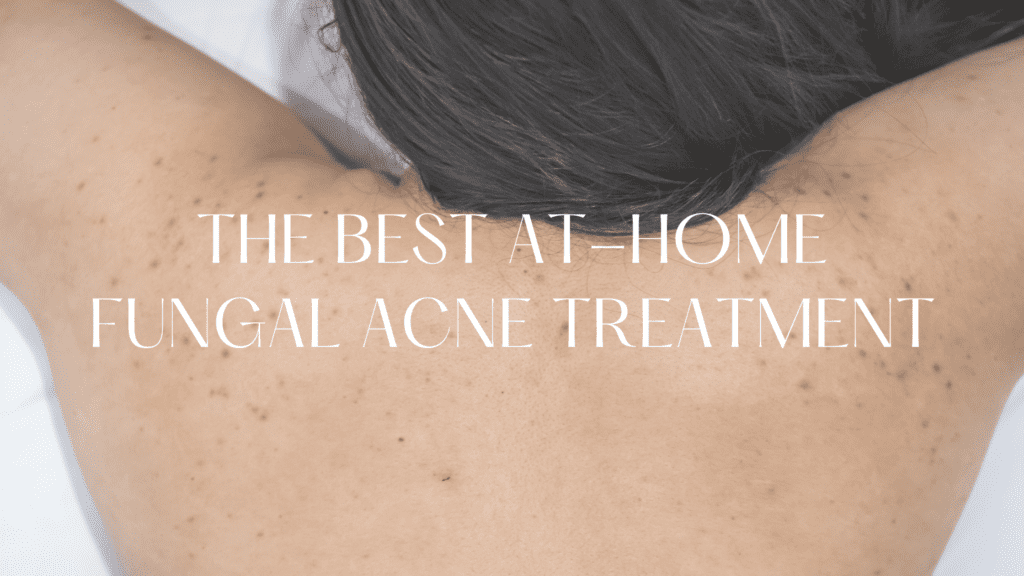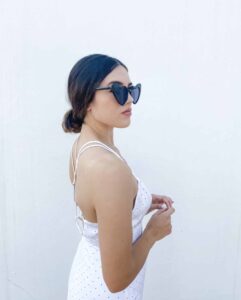Do you have fungal acne? Incorporating a fungal acne treatment at home is a super easy and effective way to achieve the smooth skin you want. Read on to learn more about what exactly fungal acne is, and the best at-home fungal acne treatments you can try.
What Is Fungal Acne?

Before we treat fungal acne, it is important to know a bit more about the science behind it.
Malassezia (Pityrosporum) folliculitis is the scienticfic name for fungal acne.
Many people who have fungal acne commonly believe that they suffer from acne vulgaris. It is actually a very separate condition that needs to be treated differently than acne vulgaris, or it may persist for years!
What Is Malassezia Folliculitis?
Malassezia folliculitis results from overgrowth of yeast present in the normal cutaneous flora.
NCBI Malassezia (Pityrosporum) Folliculitis
This certain kind of yeast thrives on the sebum on skin.
This is why it is important to determine if you have fungal acne: fungal acne is an overgrowth of yeast. Acne vulgaris is caused by p. acnes, a bacteria. Both need to be treated very differently.
Do You Have Fungal Acne Symptoms?
Here is a quick overview to determine if you have fungal acne vs. acne vulgaris:
- Fungal acne is intensely pruritic (itchy)
- Fungal acne lesions look small and very uniform in size
- The common locations for these lesions are on the face, back, arms by the back of the elbow, chest, and neck.
- When found on the face, the fungal acne lesions commonly found on the chin, and sides of the face. Compare this to the central facial lesions that tend to occur specifically with acne vulgaris.
- Fungal acne tends to mostly affect younger patients with oilier skin.
How To Treat Fungal Acne At Home
If you have determined that you do have fungal acne, here’s how to treat it at home:
A quick side note: Oral antifungals are the most effective treatment and result in rapid improvement. A dermatologist will have to prescribe these for you. If you can’t afford the medication, or can’t see a doctor just yet, try these effective ways to treat fungal acne at home FAST!
The Best Fungal Acne Treatment At Home
Drum roll … using an anti-dandruff shampoo is the best fungal acne treatment at home! In some cases, you can see improvement in as little as a week.
The reason why this specific Nizoral anti-dandruff shampoo is so effective? The main ingredient, ketoconazole, interferes with the processes of the fungal cell.1 This basically kills off the fungus. Using anti-dandruff shampoo for fungal acne is great for creating a more favorable balance of yeast on the skin.
How To Use Nizoral Shampoo For Fungal Acne
- Apply this shampoo as a face wash to the affected area. Leave it on for a few minutes, then wash it off.
- You can start by using this treatment a few times a week while dealing with the initial breakouts. Then use it weekly to maintain clear, smooth skin! The shampoo can also be used on the back, chest, arms, or wherever fungal acne is occurring!
- Make sure to use a good moisturizer as this can be drying.
Using Nizoral for fungal acne is a great at-home option that is super inexpensive too – it is under 15 dollars for a bottle that should last you a while!
How To Treat Fungal Acne Naturally
If you are curious about other fungal acne treatments at home, read on for these natural, DIY solutions :
Salt
Salt is a great natural option to get rid of fungal acne. Using salt as a fungal acne treatment at home is so effective, as the salt retards the growth of yeast. High concentrations of salt can also kill the yeast.
To use this natural treatment, mix sea salt and warm water until dissolved. Apply the solution to the affected areas with a cotton pad and let it sit on the skin overnight. The next morning, wash it off and continue with your normal skincare.
Be sure that you use SEA SALT. Table salt will not work for this, as it is extremely drying to the skin.
The minerals kept in sea salt are needed to help heal the skin as well, and will not dry out your skin. You might still want to use a moisturizer after letting this solution soak in for a few minutes if your skin is very dry.
I recommend using a Himalayan salt, or this salt from Redmond Life Real Salt:
This salt is found in Utah, in an ancient underground salt deposit. This means it is from a prehistoric ocean, and free from modern-day pollutants.
It has not been heated, so all the essential minerals are there. There are also no anti-caking additives which would not be great for the skin. You need pure sea salt for this to work for fungal acne, and this salt is the way to go.
You can also use salt on any type of breakout! Here is a blog post on how to also use salt to get rid of acne vulgaris!
Wear Breathable, Loose Clothing
This seems like an obvious point, but it is super important to be diligent about it. If you are experiencing fungal acne on the back, chest, or arms wear breathable and loose clothing. In doing so, you allow your skin to breathe and avoid creating an environment where the yeast can thrive.
Shower More Often If You Sweat
Going back to the previous point, you also want to avoid tight clothing so sweat doesn’t accumulate. Sweat creates an environment that yeast really loves.
When you do sweat, make sure to shower more often. This is especially true on hot and humid days. Keeping the skin dry and clean is best.
Eat A Balanced Diet
It is important to note that you also need to be eating well to heal your skin too. Eat less sugar/carbs as this will do wonders all around – whether you have acne, fungal acne, or aging skin too. All benefits when you take away the damaging effect of sugar on the skin. To read more about the “why” behind it, click the article below:
Read More: 5 Startling Reasons Why Sugar Is Bad For Your Skin
As seen in the article, acne vulgaris thrives on certain foods. Sugar aggravates breakouts by making the body secrete androgens and more oil. More oil for fungal acne sufferers means the yeast has more of the environment they love to thrive.
Yeast in itself also thrives on sugar.
In avoiding sugar, you can potentially lessen a mix of fungal acne and acne vulgaris for occurring.
Summary of Fungal Acne
Here is a quick summary of fungal acne:
-Fungal acne is caused by an overgrowth of yeast, and the scientific term for it is Malassezia (Pityrosporum) folliculitis.
-You might have fungal acne vs. acne vulgaris if your acne is: itchy, very small, similar sized lesions, and on the sides of the face and chin.
-The best fungal acne treatment at home is an anti-dandruff shampoo, like Nizoral.
-Other natural ways to get rid of fungal acne include: using a salt solution, wearing loose and breathable clothing, showering more often especially on hot and humid days and eating a balanced diet free from sugary foods.
Overview of The Best Fungal Acne Treatment At Home
I hope that this guide has helped you on your journey to clear skin! Using Nizoral, as well as the other natural fungal acne treatments at home mentioned here will be your best bet for getting rid of fungal acne. Not to mention, it will do it quickly, effectively, and affordably!
Best, Mia
This content is for informational purposes only, and what has worked for me personally based on my own opinions. I am not a professional/medical doctor, and you should always consult your doctor or dermatologist on what will work best for you. The information presented here is not legitimate, official advice from a professional. If you choose to rely on any information from this blog, you do so at your own risk. Please refer to the “Blog Disclaimer” tab in the menu bar to read more information and the official disclaimer statement.
Citations:
- Scheinfeld, Noah. “Ketoconazole: a review of a workhorse antifungal molecule with a focus on new foam and gel formulations.” Drugs of today (Barcelona, Spain : 1998) vol. 44,5 (2008): 369-80. doi:10.1358/dot.2008.44.5.1216598



